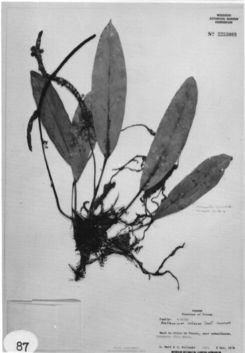




TYPE: Panama. Panama: road between Cerro Jefe and Altos de Pacora, near schoolhouse, 800-1,000 m, Mori & Kallunki 2371 (MO 2253009, holotype).
Epiphyte; stems more or less densely rooted, less than 10 cm long, 8-12 mm diam.; leaf scars hidden by cataphylls and roots; roots numerous, 2-3 mm diam., spreading or descending; cataphylls 2-3.5 cm long, drying reddish brown, promptly weathering to fine, persistent fibers, sometimes the apex more or less intact.
LEAVES erect; petiole 4-15 cm long, 2-3 mm diam., sul-cate or more or less flattened adaxially, the margins erect, rounded abaxially; geniculum 7-10 mm long; blades subcoriaceous, usually oblong-elliptic to oblanceolate-elliptic, rarely oblong-lanceolate, gradually to abruptly acuminate at apex (the acumen flattened and apiculate), acute at base, 8-17 cm long, 2.4-4.4 cm wide, broadest usually near middle; both surfaces semiglossy, eglandular above, densely and conspicuously glandular-punctate below; midrib prominently raised on both surfaces (dry); primary lateral veins 7-11 per side, departing midrib at 35-45° angle, drying prominulous or weakly etched above, prominulous below; interprimary veins only slightly less prominent than primary lateral veins on drying; collective vein arising from the base, 2-4 mm from margin, sunken above, raised below (dry).
INFLORESCENCE erect; peduncle 7.5-15 cm long, 2-3 mm diam., terete, equalling or to twice as long as petioles; spathe moderately thin, green heavily tinged red or purple, lanceolate, 2.5-7 cm long, 4-8 mm wide, broadest just above the base, usually acute to obtuse and apiculate, rarely acuminate at apex, acute to obtuse or rarely rounded at base, inserted at ca. 45° angle on peduncle; stipe usually absent, sometimes to 3 mm long; spadix red to purple, scarcely tapered toward apex, 7-12 cm long, 3-4 mm diam. at base, 2-3 mm diam. near apex; flowers rhombic, 3.5-4 mm long 2.5-3 mm wide, 2-3 flowers visible in the principal spiral, 5-6 flowers visible in the alternate spiral; tepals semiglossy, lateral te-pals 2.3-2.6 mm wide, the inner margin straight to broadly rounded; pistils not emergent, violet purple; stigmas broadly elliptic, ca. 0.3 mm long, 0.2 mm wide; stamens retracting beneath tepals after anthesis.
INFRUCTESCENCE with berries white, subglobose, 4-5 mm diam., rounded at apex; seeds 4-6, narrowly ovoid-ellipsoid, pale brown, 1.3-1.5 mm long, 0.8-1 mm wide, often oblique at apex, rounded at base, with a sticky, transparent, gelatinous covering at both ends. Fig. 87.
Anthurium jefense is endemic to Panama with most collections made in the vicinity of Cerro Jefe in Panama Province at 1,000 to 1,200 m in premontane rain forest. A collection at about 400 m on the El Llano-Carti Road (Folsom 3595) is probably also this species.
The species is a member of section Porphyrochitonium and is distinguished by its subcoria-ceous, lanceolate-elliptic to oblong-elliptic, acuminate blades, its narrowly sulcate petioles usually shorter than the blades, its long-pedunculate inflorescence with a narrowly cylindroid, scarcely tapered, dark violet purple spadix, and by its white berries.
It is most easily confused with Anthurium supraglandulum with which it occurs on Cerro Jefe, but that species differs in having blades merely acute to bluntly acuminate at the apex and in having glands on the upper surface of the blade. Dried plants of A. jefense lack such glands on the upper surface.

Panama Panamá:, 1978, Kamemoto (Cult) 239 (MO).
Panama Panamá: Cerro Jefe, 800 m,, , Croat 73979 (MO).
Panama: vicinity Cerro Jefe, António 4720 (MO), Dwyer et
al. 5044 (MO), Folsom 3611, 3832 (MO), Folsom & Page
5946 (MO), Mori & Kallunki 2371 (MO), Porter et al. 5070
(MO), Witherspoon 8584 (MO);
El Llano-Cani Road, Folsom 3595 (MO).